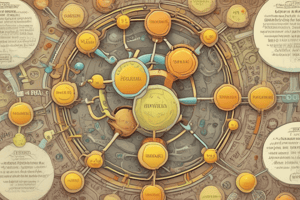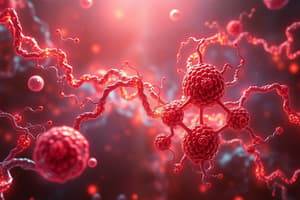Podcast
Questions and Answers
What is a common clinical condition associated with carnitine deficiency?
What is a common clinical condition associated with carnitine deficiency?
- Preterm infants (correct)
- Severe dehydration
- Hypertension
- Diabetes mellitus
What is the primary symptom of carnitine deficiency?
What is the primary symptom of carnitine deficiency?
- Episodic hypoglycemia (correct)
- Weight loss
- Chronic pain
- Constant fatigue
Which enzyme deficiency leads to dicarboxylic aciduria?
Which enzyme deficiency leads to dicarboxylic aciduria?
- Carnitine palmitoyltransferase
- Long-chain fatty acyl-CoA synthetase
- Mitochondrial medium chain acyl-CoA dehydrogenase (correct)
- Short-chain acyl-CoA dehydrogenase
What is the consequence of the enzyme deficiency in Refsum disease?
What is the consequence of the enzyme deficiency in Refsum disease?
Which condition is characterized by the inherited absence of peroxisomes?
Which condition is characterized by the inherited absence of peroxisomes?
What is the role of ATP in the activation of fatty acids?
What is the role of ATP in the activation of fatty acids?
How do long-chain fatty acids penetrate the inner mitochondrial membrane?
How do long-chain fatty acids penetrate the inner mitochondrial membrane?
Which coenzymes are utilized during fatty acid oxidation?
Which coenzymes are utilized during fatty acid oxidation?
What is the end product of β-oxidation of palmitoyl-CoA?
What is the end product of β-oxidation of palmitoyl-CoA?
Where does fatty acid oxidation predominantly take place within the cell?
Where does fatty acid oxidation predominantly take place within the cell?
Which amino acids can be synthesized to produce carnitine?
Which amino acids can be synthesized to produce carnitine?
In what form are fatty acids transported in the blood?
In what form are fatty acids transported in the blood?
What distinguishes fatty acid oxidation from fatty acid biosynthesis?
What distinguishes fatty acid oxidation from fatty acid biosynthesis?
What happens to odd-chain fatty acids during β-oxidation?
What happens to odd-chain fatty acids during β-oxidation?
Which of the following statements is true regarding peroxisomal β-oxidation?
Which of the following statements is true regarding peroxisomal β-oxidation?
What is a characteristic feature of α-oxidation of fatty acids?
What is a characteristic feature of α-oxidation of fatty acids?
How does the oxidation of unsaturated fatty acids differ from saturated fatty acids?
How does the oxidation of unsaturated fatty acids differ from saturated fatty acids?
Which enzyme is essential for the oxidation of monounsaturated fatty acids?
Which enzyme is essential for the oxidation of monounsaturated fatty acids?
What is the role of cytochrome P450 in ω-oxidation of fatty acids?
What is the role of cytochrome P450 in ω-oxidation of fatty acids?
What byproduct is generated during the initial dehydrogenation of β-oxidation in peroxisomes?
What byproduct is generated during the initial dehydrogenation of β-oxidation in peroxisomes?
What is the relationship between propionyl-CoA and glucose metabolism?
What is the relationship between propionyl-CoA and glucose metabolism?
Flashcards
Carnitine deficiency
Carnitine deficiency
A condition where the body has trouble transporting fatty acids for energy production, leading to hypoglycemia and muscular weakness.
Dicarboxylic aciduria
Dicarboxylic aciduria
A disorder caused by a lack of a specific enzyme (medium-chain acyl-CoA dehydrogenase), affecting beta-oxidation and leading to the excretion of certain fatty acid byproducts.
Refsum disease
Refsum disease
An inherited disorder causing a buildup of phytanic acid, primarily affecting the nervous system due to a lack of a specific enzyme (alpha-hydroxylase).
Zellweger syndrome
Zellweger syndrome
Signup and view all the flashcards
Fatty acid oxidation
Fatty acid oxidation
Signup and view all the flashcards
Fatty Acid Activation
Fatty Acid Activation
Signup and view all the flashcards
Fatty Acid Transport into Mitochondria
Fatty Acid Transport into Mitochondria
Signup and view all the flashcards
β-Oxidation
β-Oxidation
Signup and view all the flashcards
Fatty Acid Oxidation Location
Fatty Acid Oxidation Location
Signup and view all the flashcards
Carnitine's Role
Carnitine's Role
Signup and view all the flashcards
Fatty Acid Transport in Blood
Fatty Acid Transport in Blood
Signup and view all the flashcards
Products of Beta-oxidation
Products of Beta-oxidation
Signup and view all the flashcards
Energy Source of Fatty Acids
Energy Source of Fatty Acids
Signup and view all the flashcards
β-oxidation of fatty acids
β-oxidation of fatty acids
Signup and view all the flashcards
Odd-chain fatty acid oxidation
Odd-chain fatty acid oxidation
Signup and view all the flashcards
Propionyl-CoA conversion
Propionyl-CoA conversion
Signup and view all the flashcards
Peroxisomal β-oxidation
Peroxisomal β-oxidation
Signup and view all the flashcards
Unsaturated fatty acid oxidation
Unsaturated fatty acid oxidation
Signup and view all the flashcards
Isomerase enzyme
Isomerase enzyme
Signup and view all the flashcards
Study Notes
Oxidation of Fatty Acids
- Fatty acids (FAs) are oxidized to acetyl-CoA and synthesized from acetyl-CoA.
- FA oxidation is a different process than FA biosynthesis, occurring in a separate cellular compartment.
- FA oxidation takes place in the mitochondria.
- FA oxidation is an aerobic process, requiring oxygen.
- NAD and FAD are used as co-enzymes, generating ATP.
- FAs are transported in the blood as free FAs.
- Longer-chain FAs are bound to albumin and then to a binding protein in cells.
Objectives
- Describe the processes of transporting FAs in the blood, activating them, and transporting them into mitochondria for breakdown.
- Outline the β-oxidation pathway for metabolizing FAs into acetyl-CoA.
- Explain how this pathway leads to ATP production.
Steps of FA Oxidation
- Activation: This is the only energy-requiring step in complete FA degradation, using ATP. Fatty acid + ATP + CoA → Acyl-CoA + AMP + PPi. Several acyl-CoA synthetases (thiokinases) exist, each specific to FA chain lengths.
- Transport of long-chain FAs into mitochondria: Short-chain FAs can be oxidized directly inside the mitochondria, independent of carnitine. Long-chain acyl-CoA cannot penetrate the inner mitochondrial membrane unless it forms acyl carnitine.
- Long-chain FAs: These penetrate the inner mitochondrial membrane as carnitine derivatives. Carnitine (β-hydroxy-γ-trimethyl ammonium butyrate) is abundant in muscle and can be obtained from the diet or synthesized from lysine and methionine in the liver and kidney.
β-oxidation of Fatty Acids
- In β-oxidation, two carbons are activated at a time, starting from the carboxyl end of the acyl-CoA molecule.
- The chain is broken between α(2) and β(3) carbons.
- The resulting two-carbon units are acetyl-CoA molecules. For example, palmitoyl-CoA (16 carbons) forms 8 acetyl-CoA molecules.
- Several enzymes (collectively known as FA oxidase) catalyze the reaction in the mitochondrial matrix or inner membrane adjacent to the respiratory chain.
- These steps couple acyl-CoA oxidation with ADP phosphorylation to ATP.
Oxidation of Odd-Number FAs
- Odd-number FAs are also oxidized via β-oxidation, creating acetyl-CoA until a 3-carbon propionyl-CoA residue remains.
- Propionyl-CoA is converted to succinyl-CoA (a citric acid cycle constituent).
- The propionyl residue is the only glucogenic portion of the odd-number FA.
β-oxidation in Peroxisomes
- Very long-chain FAs (20 carbons or more) undergo preliminary β-oxidation in peroxisomes, yielding acetyl-CoA and H2O2.
- The initial step of dehydrogenation is catalyzed by an FAD-containing acyl-CoA oxidase, unique to peroxisomal β-oxidation.
- The produced FADH2 is oxidized by molecular oxygen, generating H2O2. This H2O2 is then reduced to H2O by catalase.
- Peroxisomal β-oxidation isn't directly linked to ATP production. However, its role includes shortening the side chain of cholesterol during bile acid formation and participation in plasmalogen, cholesterol, and dolichol synthesis.
α-oxidation of FAs
- α-oxidation involves removing one carbon from the carboxyl end of the FA molecule, primarily occurring in brain tissue.
- Branched-chain FAs (e.g., phytanic acid), due to their methyl group on the β-carbon, are not substrates for acyl-CoA dehydrogenase.
- Instead, these FAs are hydroxylated at the α-carbon by an α-hydroxylase and subsequently decarboxylated to generate a CoA derivative that enters the β-oxidation pathway.
- α-oxidation does not lead to high-energy phosphate production.
ω-oxidation of FAs
- ω-oxidation is a minor pathway that occurs in the endoplasmic reticulum (ER), involving cytochrome P450-dependent hydroxylases.
- The ω-carbon (the last carbon) of the FA is hydroxylated, followed by oxidation to form a carboxyl group. The final product is a dicarboxylic acid.
Oxidation of Unsaturated FAs
- Unsaturated FAs yield less energy compared to saturated FAs because they are less reduced and produce fewer reducing equivalents (NADH and FADH2).
Oxidation of Monounsaturated FAs
- Monounsaturated fatty acids (e.g. oleic acid), require 2,3-enoyl-CoA isomerase to convert a 3-cis derivative after several β-oxidation cycles to a 2-trans derivative to be used by the hydroxylase.
Oxidation of Polyunsaturated FAs
- The oxidation of polyunsaturated FAs (e.g., linoleic acid) necessitates NADPH-dependent reductase in addition to the isomerase.
Clinical Conditions
-
Carnitine deficiency: Characterized by episodic hypoglycemia and muscle weakness. Causes include preterm infants, liver disease, malnutrition, vegetarianism, pregnancy, severe infections, burns, trauma, or hemodialysis, or organic aciduria. Treatment involves oral carnitine supplementation.
-
Inherited defects in β-oxidation enzymes: lead to nonketotic hypoglycemia, coma, and fatty liver.
-
Dicarboxylic aciduria: Excretion of C6-C10 ω-dicarboxylic acids and nonketotic hypoglycemia. Due to a lack of mitochondrial medium-chain acyl-CoA dehydrogenase, the oxidation of long and medium-chain FAs is impaired, leading to the buildup and excretion of dicarboxylic acids.
-
Refsum disease: A rare, autosomal recessive disorder caused by a α-hydroxylase deficiency, resulting in phytanic acid accumulation. Symptoms are primarily neurological.
-
Zellweger's syndrome: An inherited condition characterized by the absence of peroxisomes in all tissues. It leads to the accumulation of very long-chain FAs in the blood and tissues.
Studying That Suits You
Use AI to generate personalized quizzes and flashcards to suit your learning preferences.




